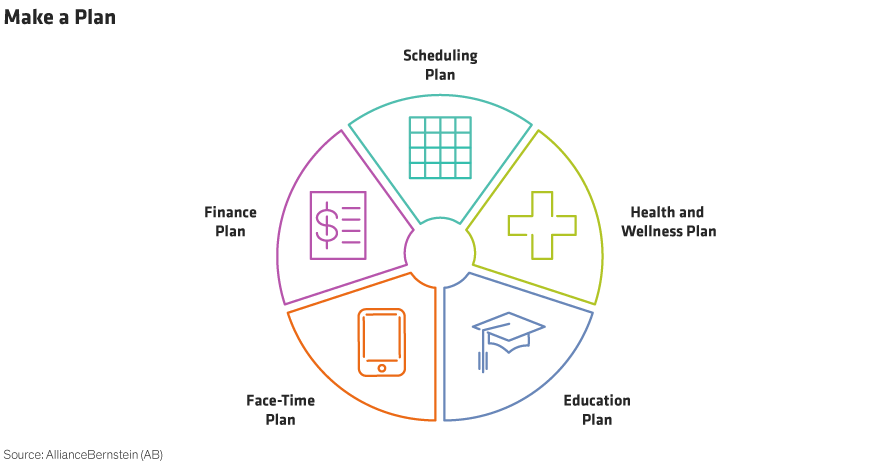As people around the world seek to flatten the curve of COVID-19, disrupted daily routines have become a source of stress. Activities which felt effortless under normal circumstances—like dropping the kids off at school, or with an extended family member—are now rife with decision making. And our attempts to achieve structure may shift dramatically depending on whether we are isolating as individuals, couples, caregivers, or co-parents within a blended family.
According to the last US Census, 16% of children are considered members of blended families, living with stepparents, stepsiblings, or half-siblings. How is it even possible to shelter in place when your children or stepchildren divide their time between households? Perhaps more important, what if co-parents hold vastly different priorities in terms of wealth, health, safety, and daily structure?
Find Commonality with Your Co-Parent
The key is communication.
When it comes to shared custody and childrearing responsibilities, sheltering in place can easily amplify already complicated interfamily dynamics. Be practical and transparent in your decision making. The steps below may help limit stress, confusion, and tension.
First, identify how your old status quo has changed now that you can no longer rely on grandparents, sitters, or extracurriculars. Do you plan to self-isolate in your usual home, or a vacation home? If you are working from home, what will your daily routine look like? In what ways will you be available to assist with home schooling?
Second, make a list of the values you hold dear. Ideally, you’ll find overlap in each home. But in reality, co-parents often need to decide what is most important, and both sides need to compromise. In cases where you share values, present a unified front to your children.
Finally, compare your own updated expectations with those of your children’s relevant family members as early as possible. You may have already established strict rules, schedules, and boundaries, but none of you have ever faced a global pandemic before, so it is worth reexamining. Resources might be different between households. The tolls on each of you—in terms of finances, health, or day-to-day routine—will likely differ. Remind all parties that they aren’t the only family dealing with change while reassuring them that they’re not entirely alone.
The Kids Come First
Co-parents need to work together to identify their children’s best interests and needs when it comes to health, safety, and continuity. Right now, your kids may not understand what is happening, or they may be scared, and they could benefit a lot from a little extra parental protection and reassurance. That’s why it’s best to continue to follow agreed-upon custody orders, while preparing to be flexible.
Here are some suggested plans to put in place:

Make a scheduling plan: Do not try to reinvent a custody schedule, even given the current circumstances. Your agreement is intentionally specific and exists to avoid miscommunications and misunderstandings. Sticking to the agreed-upon schedule can also limit disagreements and tension between co-parents.
Most importantly, sticking to preexisting schedules is also the law. Courts across the country have made it clear that the recent stay in place orders do not supersede current custody orders and should not be used to thwart another parent’s custodial time.
Make a health and wellness plan: Create a joint household “bubble” when it comes to external social interactions. Have a plan in place to potentially revisit the custody schedule if a member of either family gets sick. If you, as a parent, become sick, it might make sense to decline some parenting time.
Make an education plan: Agree upon how you will oversee schooling and schoolwork. You may need to reset where and how exchanges occur now that schools are closed. Some blended families are spending their days together, co-working while working from home.
Make a “face-time” plan: If one parent or set of parents must self-distance, keep in touch, regularly, through technology like Zoom, Skype, or FaceTime.
Make a finance plan: You should also address how you’ll be dividing expenses now that time spent with the brood has changed. One of you may have paid for extracurriculars or school expenses that have since been reimbursed. Openness with expenses now will help ease possible tension down the line.
Take It Month by Month
When communicating with members of your blended family, try to be patient, understanding, transparent, and, above all, nonconfrontational. Take it month by month. If you cannot agree on a temporary adjustment to past arrangements, look to a parenting coordinator or a mediator for guidance. And remember, even though your usual day-to-day structure may have been upended by unexpected stressors, such times of adversity can also bring opportunities to strengthen family bonds.
The views expressed herein do not constitute and should not be considered to be legal or tax advice. The tax rules are complicated, and their impact on a particular individual may differ depending on the individual’s specific circumstances. Please consult with your legal or tax advisor regarding your specific situation.